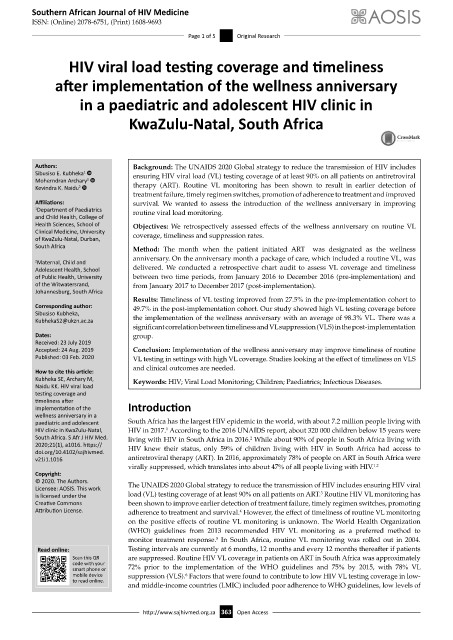Page 371 - HIVMED_v21_i1.indb
P. 371
Southern African Journal of HIV Medicine
ISSN: (Online) 2078-6751, (Print) 1608-9693
Page 1 of 5 Original Research
HIV viral load testing coverage and timeliness
after implementation of the wellness anniversary
in a paediatric and adolescent HIV clinic in
KwaZulu-Natal, South Africa
Authors: Background: The UNAIDS 2020 Global strategy to reduce the transmission of HIV includes
Sibusiso E. Kubheka ensuring HIV viral load (VL) testing coverage of at least 90% on all patients on antiretroviral
1
Moherndran Archary 1
Kevindra K. Naidu 2 therapy (ART). Routine VL monitoring has been shown to result in earlier detection of
treatment failure, timely regimen switches, promotion of adherence to treatment and improved
Affiliations: survival. We wanted to assess the introduction of the wellness anniversary in improving
1 Department of Paediatrics routine viral load monitoring.
and Child Health, College of
Health Sciences, School of Objectives: We retrospectively assessed effects of the wellness anniversary on routine VL
Clinical Medicine, University coverage, timeliness and suppression rates.
of KwaZulu-Natal, Durban,
South Africa Method: The month when the patient initiated ART was designated as the wellness
anniversary. On the anniversary month a package of care, which included a routine VL, was
2 Maternal, Child and
Adolescent Health, School delivered. We conducted a retrospective chart audit to assess VL coverage and timeliness
of Public Health, University between two time periods, from January 2016 to December 2016 (pre-implementation) and
of the Witwatersrand, from January 2017 to December 2017 (post-implementation).
Johannesburg, South Africa
Results: Timeliness of VL testing improved from 27.5% in the pre-implementation cohort to
Corresponding author: 49.7% in the post-implementation cohort. Our study showed high VL testing coverage before
Sibusiso Kubheka,
[email protected] the implementation of the wellness anniversary with an average of 98.3% VL. There was a
significant correlation between timeliness and VL suppression (VLS) in the post-implementation
Dates: group.
Received: 23 July 2019
Accepted: 24 Aug. 2019 Conclusion: Implementation of the wellness anniversary may improve timeliness of routine
Published: 03 Feb. 2020 VL testing in settings with high VL coverage. Studies looking at the effect of timeliness on VLS
and clinical outcomes are needed.
How to cite this article:
Kubheka SE, Archary M, Keywords: HIV; Viral Load Monitoring; Children; Paediatrics; Infectious Diseases.
Naidu KK. HIV viral load
testing coverage and
timeliness after
implementation of the Introduction
wellness anniversary in a
paediatric and adolescent South Africa has the largest HIV epidemic in the world, with about 7.2 million people living with
HIV clinic in KwaZulu-Natal, HIV in 2017. According to the 2016 UNAIDS report, about 320 000 children below 15 years were
1
South Africa. S Afr J HIV Med. living with HIV in South Africa in 2016. While about 90% of people in South Africa living with
2
2020;21(1), a1016. https://
doi.org/10.4102/sajhivmed. HIV knew their status, only 59% of children living with HIV in South Africa had access to
v21i1.1016 antiretroviral therapy (ART). In 2016, approximately 78% of people on ART in South Africa were
virally suppressed, which translates into about 47% of all people living with HIV. 1,2
Copyright:
© 2020. The Authors. The UNAIDS 2020 Global strategy to reduce the transmission of HIV includes ensuring HIV viral
Licensee: AOSIS. This work
3
is licensed under the load (VL) testing coverage of at least 90% on all patients on ART. Routine HIV VL monitoring has
Creative Commons been shown to improve earlier detection of treatment failure, timely regimen switches, promoting
Attribution License. adherence to treatment and survival. However, the effect of timeliness of routine VL monitoring
4
on the positive effects of routine VL monitoring is unknown. The World Health Organization
(WHO) guidelines from 2013 recommended HIV VL monitoring as a preferred method to
monitor treatment response. In South Africa, routine VL monitoring was rolled out in 2004.
5
Read online: Testing intervals are currently at 6 months, 12 months and every 12 months thereafter if patients
Scan this QR are suppressed. Routine HIV VL coverage in patients on ART in South Africa was approximately
code with your
smart phone or 72% prior to the implementation of the WHO guidelines and 75% by 2015, with 78% VL
mobile device suppression (VLS). Factors that were found to contribute to low HIV VL testing coverage in low-
6
to read online.
and middle-income countries (LMIC) included poor adherence to WHO guidelines, low levels of
http://www.sajhivmed.org.za 363 Open Access

